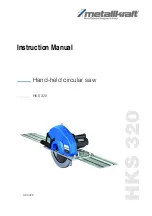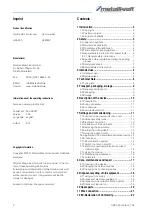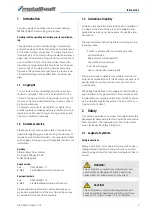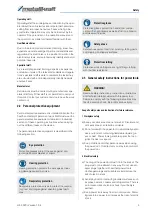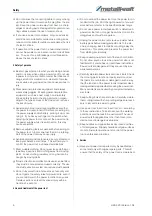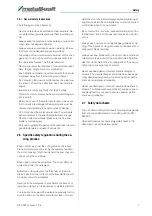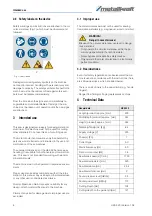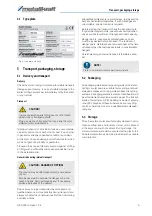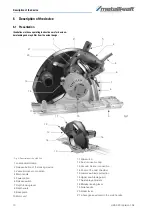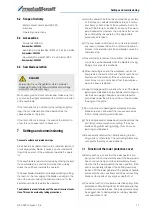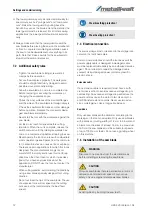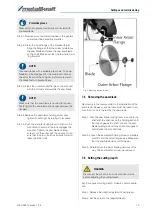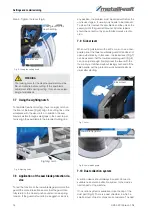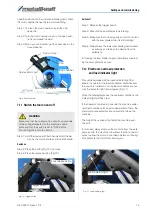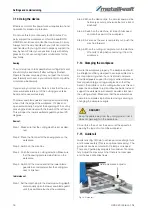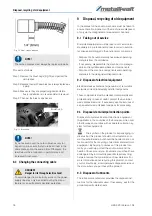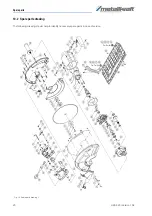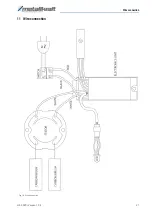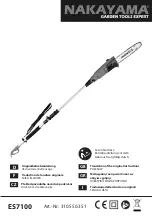
6
HKS 320 | Version 1.04
Safety
d) Do not misuse the connecting cable to carry or hang
up the power tool or to remove the plug from the soc-
ket. Keep the power cord away from heat, oil, sharp
edges or moving parts. Damaged or tangled connec-
ting cables increase the risk of electric shock.
e) If you use a power tool outdoors, only use extension
cords that are suitable for outdoor use. Using an ex-
tension cord suitable for outdoor use reduces the risk
of electric shock.
f) If operation of the power tool in a humid environment
cannot be avoided, use a sensor current circuit brea-
ker. The use of an earth leakage circuit breaker re-
duces the risk of electric shock.
3 Safety of persons
a) Be alert, pay attention to what you are doing and use
common sense when using a power tool. Do not use
a power tool if you are tired or under the influence of
drugs, alcohol or medication. A moment of careles-
sness while using a power tool can cause serious in-
jury.
b) Wear personal protective equipment and always
wear safety goggles. Wearing personal protective
equipment, such as a dust mask, non-slip safety
shoes, safety helmet or hearing protection, depen-
ding on the type and use of the power tool, reduces
the risk of injury.
c) Avoid unintentional commissioning. Make sure that
the power tool is switched off before connecting it to
the power supply and/or battery, picking it up or car-
rying it. If you have your finger on the switch when
carrying the power tool or connect the power tool to
the power supply while it is switched on, this may
cause accidents.
d) Remove adjusting tools or spanners before turning on
the power tool. A tool or spanner that is in a rotating
part of the power tool may cause injury.
e) Avoid abnormal posture. Ensure a secure stand and
keep your balance at all times. This will help you to
control the power tool in unexpected situations.
f) Wear suitable clothing. Do not wear loose clothing or
jewellery. Keep hair and clothing away from moving
parts. Loose clothing, jewellery or long hair can be
caught by moving parts.
g) If dust extraction and collection devices can be fitted,
they must be connected and used correctly. The use
of a dust extraction system can reduce dust hazards.
h) Do not lull yourself into a false sense of security and
do not ignore the safety rules for power tools, even if
you are familiar with the power tool after many uses.
Careless action can lead to serious injury within a
fraction of a second.
4 Use and treatment of the power tool
a) Do not overload the power tool. Use the power tool in-
tended for the job. With the right power tool you will
work better and safer in the specified power range.
b) Do not use a power tool whose switch is defective. A
power tool that can no longer be switched on or off is
dangerous and must be repaired.
c) Unplug the power cord and/or remove a detachable
battery pack before making adjustments to the ma-
chine, changing insert tool parts or putting away the
power tool. This precaution prevents the power tool
from starting accidentally.
d) Keep unused power tools out of the reach of children.
Do not allow anyone to use the power tool who is not
familiar with it or who has not read these instructions.
Power tools are dangerous if they are used by inex-
perienced persons.
e) Carefully maintain power tools and insert tools. Check
that moving parts function properly and do not jam,
that parts are not broken or damaged in such a way
that the function of the power tool is impaired. Have
damaged parts repaired before using the power tool.
Many accidents are caused by poorly maintained po-
wer tools.
f) Keep cutting tools sharp and clean. Carefully mainta-
ined cutting tools with sharp cutting edges are less li-
kely to jam and are easier to guide.
g) Use power tool, insert tool, insert tool, etc. according
to these instructions. Take into account the working
conditions and the task to be performed. The use of
power tools for applications other than those inten-
ded can lead to dangerous situations.
h) Keep handles and grip surfaces dry, clean and free
of oil and grease. Slippery handles and grip surfaces
do not allow safe operation and control of the power
tool in unforeseen situations.
5 Service
a) Have your power tool repaired only by qualified per-
sonnel and only with original spare parts. This will
ensure that the safety of the power tool is maintained.

